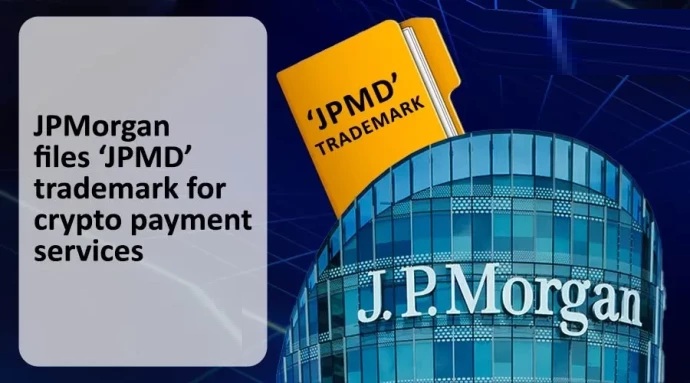
J.P. Morgan is launching JPMD, a permissioned USD deposit token, on Coinbase’s Base blockchain, an Ethereum Layer-2 network. Unlike stablecoins, JPMD represents a digital claim on actual dollar deposits held at the bank, aimed at institutional clients for fast, secure, 24/7 on-chain transactions, such as cross-border payments and asset settlements. The pilot program, set to begin within days, will initially involve select Coinbase institutional clients, with plans to expand to other users and currencies pending regulatory approval.
JPMD is designed to integrate with J.P. Morgan’s Kinexys platform, which processes over $2 billion in daily transactions, and offers potential interest-bearing features, distinguishing it from typical stablecoins. This move marks the first time a major U.S. bank has deployed a deposit-based product on a public blockchain, signaling a significant step in blending traditional banking with blockchain technology. J.P. Morgan’s launch of JPMD on Coinbase’s Base blockchain signals a major step toward integrating traditional banking with public blockchain infrastructure.
As the first major U.S. bank to deploy a deposit token on a public chain, it could encourage other financial institutions to explore similar initiatives, accelerating blockchain adoption in institutional finance. The use of a permissioned USD deposit token (representing actual dollar deposits) rather than a stablecoin bridges the gap between traditional banking and decentralized finance (DeFi), potentially legitimizing public blockchains for high-value, regulated transactions. JPMD enables 24/7, near-instantaneous transactions for institutional clients, streamlining cross-border payments, asset settlements, and other financial operations.
Register for Tekedia Mini-MBA edition 19 (Feb 9 – May 2, 2026): big discounts for early bird.
Tekedia AI in Business Masterclass opens registrations.
Join Tekedia Capital Syndicate and co-invest in great global startups.
Register for Tekedia AI Lab: From Technical Design to Deployment (next edition begins Jan 24 2026).
This could reduce reliance on slower, traditional systems like SWIFT, cutting costs and settlement times. Integration with J.P. Morgan’s Kinexys platform, which already handles $2 billion in daily transactions, suggests JPMD could scale rapidly, offering a robust alternative to existing payment rails. The pilot’s success hinges on regulatory approval, particularly from U.S. authorities. A successful rollout could set a precedent for how regulators view tokenized deposits on public blockchains, potentially shaping future policies for digital assets in banking.
The permissioned nature of JPMD ensures compliance with KYC/AML requirements, addressing regulatory concerns while leveraging blockchain’s transparency and efficiency. By launching JPMD, J.P. Morgan positions itself as a leader in the evolving digital finance landscape, competing with fintechs and crypto-native firms offering tokenized payment solutions. This could pressure other banks to innovate or risk losing market share.
The potential for interest-bearing features on JPMD could attract institutional clients, offering a unique value proposition compared to non-interest-bearing stablecoins. Deploying JPMD on Base, an Ethereum Layer-2, validates the scalability and cost-efficiency of L2 solutions for institutional use cases. This could drive further development and adoption of Base and similar networks. It may also pave the way for greater interoperability between traditional finance and DeFi, as institutional-grade tokens like JPMD could eventually interact with DeFi protocols under controlled conditions.
JPMD is permissioned, meaning J.P. Morgan retains control over access, issuance, and compliance. This contrasts with the decentralized ethos of public blockchains, creating a divide between traditional banking’s gated systems and DeFi’s open, permissionless networks. Crypto purists may view JPMD as a co-optation of blockchain technology, prioritizing institutional control over decentralization. This could spark debates about the “true” purpose of blockchain in finance.
JPMD is designed for institutional clients, initially limited to select Coinbase clients. This excludes retail users and smaller entities, reinforcing a divide between well-resourced institutions and the broader public. The high entry barriers for institutional-grade products like JPMD could widen the gap between large financial players and smaller market participants, limiting the democratizing potential of blockchain.
The pilot’s reliance on regulatory approval highlights the divide between innovation and compliance. While J.P. Morgan’s involvement may push regulators to clarify rules for tokenized deposits, any delays or restrictions could slow broader adoption. Globally, differing regulatory frameworks may create a patchwork of adoption, with some regions embracing tokenized banking products faster than others, deepening geographic disparities.
Not all financial institutions have the resources or expertise to deploy blockchain-based solutions like JPMD, creating a divide between tech-forward banks and those lagging behind. While JPMD operates on Base, integrating with other blockchains or legacy systems could be complex, potentially isolating it from broader crypto ecosystems. JPMD’s distinction as a deposit token (backed by actual bank deposits) versus stablecoins (often backed by reserves or assets) creates a competitive divide. Stablecoin issuers like Tether or Circle may face increased scrutiny or pressure to align with banking standards, while deposit tokens could gain favor among regulators and institutions.
However, stablecoins’ broader accessibility and established market presence like USDT, USDC may maintain their dominance in retail and DeFi, creating a bifurcated market. J.P. Morgan’s JPMD launch is a pivotal moment for blockchain in traditional finance, promising faster, more efficient transactions and potentially reshaping regulatory frameworks. However, it also underscores divides between centralized and decentralized finance, institutional and retail access, and technological haves and have-nots.



